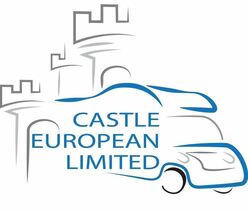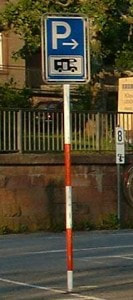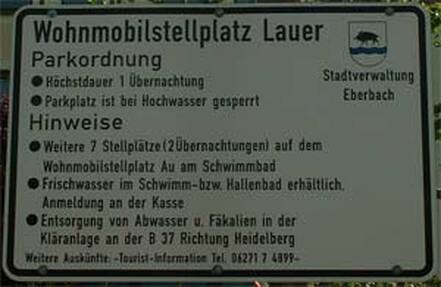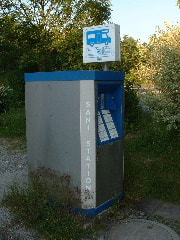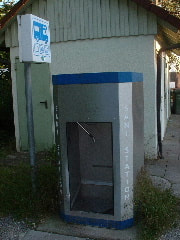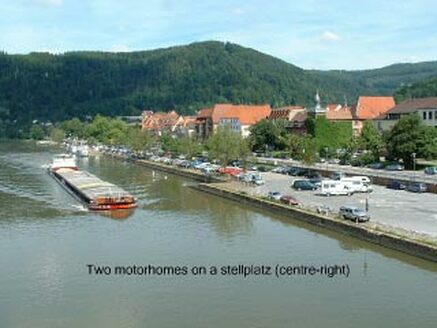Germany
Famous for great beer, sausages, cars, gourmet food, Berlin Wall, football, Nuremberg Christmas Market, cuckoo clocks, bread, Black Forest, palaces and castles, Oktoberfest, Munich and more.
|
Stellplatz (Stopping place)
A Stellplatz is a stopping place where you can spend at least one night camping in your motorhome.
It is not a campsite. Facilities vary from place to place. The focus of a German Stellplatz is to provide a place to park for the night, somewhere to sleep. |
Finding Stellplatze
Stellplatz guide books are available at camping stores, motorhome dealers, book shops, railway stations and are published by a major German motorhome magazine.
It’s written in German but easily understood due to the many symbols used throughout. It also provides geographic coordinates for GPS use. |
Parking and service facilities
|
A motorhome icon will identify a stellplatz, and these will often have parking or camping charges per hour or per night displayed. There is generally a limit to how long you may stay at a stellplatz and this is normally displayed on a sign. Expect this to be in the order of two or three days/nights. Sometimes a stellplatz may only be available on certain days of the week. Again this limitation will be displayed. Many stellplatz are run by local councils, but there are also privately run sites at service stations, marinas, vineyards, and even alongside campsites. They vary in their attractiveness from tidy, picturesque and quiet park-like areas to active, noisy places at the back of busy service stations.
Even the least attractive stellplatz is preferable to spending the night on a service area on the autobahn. We don’t recommend autobahn service areas as overnight stops due to security concerns. There are sufficient stellplätze that you should never need to do this. Whilst they may be more like car parks than campsites they’re usually safe and you’ll probably be in the company of other campervans. Look for the easily recognised Stellplatz signs.
Although the focus of a stellplatz is providing an overnight stopping place, most sites now offer at least some services such as fresh water, toilet and grey tank emptying facilities and even power connection. The stellplatz guide books detail the facilities available at each place – see “Finding Stellplätze” below. At sites without facilities there is usually a sign directing you to the nearest service point – though you may have to brush-up on your German.
Facilities are usually provided by a standardised service post manufactured as a unit and installed at the site. The most commonly seen version is the “Holiday-Clean” which has a common emptying point for grey and black water beneath a lid at the base. This can be flushed by pressing a button on the front of the post. Using the drain service is free however there is a charge for fresh water and connection is made to the outlet by a half inch thread hose fitting. If there is a 'drive-over' drain this will be intended for grey water only and not for toilet waste.
|
Another commonly seen service unit is the “Sani-Station”.
These are a little more sophisticated, everything being coin operated and controlled by a timer. Have everything ready before you put your coin in the machine! Having inserted the correct coin a green light will come on and you then select which function you wish to use – dumping or fresh water. For dumping a shutter will open allowing emptying of a grey tank (you’ll need a hose) or toilet waste.There will be a short hose there for flushing the waste drain. You will be warned that the shutter is about to close by a beeping sound and you’ll have time to quickly insert another coin to keep the shutter open if necessary. If you’ve selected fresh water then the supply will be cut after a certain length of time. A third popular model of service unit is the 'ST-SAN'. These are stainless steel and have a “drive-over” drain in the ground a couple of metres away. Open the lid then drive over the drain to empty your tanks. They can be used for both grey and black water. There will be a knob on the front panel of the box for flushing the drain, and on the side will be a coin operated fresh water supply. Most stellplatz service points are frost protected but if you’re touring in winter you may find some of them turned off if they’re not protected against freezing.
Some stellplatz offer electricity hook ups. These are usually the blue CE sockets seen at campsites but the supply is generally limited to 4.0 amps. Don’t expect to run a heater. Fees vary but expect to pay by the kilowatt hour or for a set length of time such as ten hours. Occasionally electricity is free or included with the overnight parking fee, but this is the exception rather than the rule. You may find that there aren’t enough hook-ups for everyone on the stellplatz so if you’re one of the later arrivals you might miss out. Locally there are black and white signs indicating the location of a stellplätze. Paying
Obviously if there is a service point at the stellplatz you’ll have to insert coins to use the facilities. Few if any machines will accept credit cards so keep a supply of 50c, 1€ and 2€ coins on hand. The French Jeton (token) system is not used in Germany.
For your overnight stay there may be a pay and display machine similar to those found on some car parks. Alternatively someone may come round to collect the fee, and there may be a box for you to leave your payment if you leave before the warden arrives. At privately run stellplätze you are expected to approach the service station, marina office, vineyard owner etc yourself and offer your payment. |
|
CASTLE EUROPEAN - YOUR NEW ZEALAND MOTORHOME IMPORTING SPECIALISTS
+64 (0) 21 157 0047
RMVT 381810 | NZMCA 86029
|
QUICK LINKS
|
